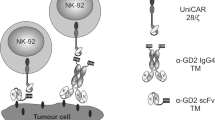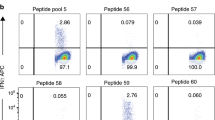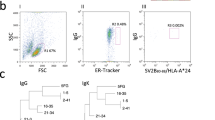Abstract
Advances in adoptive cell immunotherapy have led to several promising options for cancer patients. Single-chain variable fragments (scFvs) were isolated from a human phage display library by panning on recombinant human leukocyte antigen (HLA)-A2-peptide complexes. A scFv (EBNA Clone 315) specific for HLA-A2 carrying a 10 amino acid peptide (LLDFVRFMGV) derived from the Epstein–Barr virus latent protein EBNA3C was fully characterized. EBNA Clone 315 displayed exquisite specificity toward its targeted T-cell epitope (TCE) and did not cross-react with the free peptide, HLA-A2 complexes, which carried irrelevant peptides, or HLA-A2− cells. Furthermore, after engineering into a scFv–Fc fusion protein, we were able to determine its affinity, detection sensitivity, and ability to induce antibody-dependent cellular cytotoxicity (ADCC). As a proof-of-principle, a chimeric antigen receptor (CAR) version of EBNA Clone 315 was used to reprogram NK92MI cells. CAR-expressing NK92MI cells showed highly specific and potent cytotoxicity toward the targeted TCE, with detection sensitivity of approximately 25 molecules and cytolytic capacity threefold greater than scFv-Fc-mediated ADCC. For the first time, we show the successful reprogramming of non-T cells toward a specific TCE using a CAR.
This is a preview of subscription content, access via your institution
Access options
Subscribe to this journal
Receive 12 print issues and online access
$259.00 per year
only $21.58 per issue
Buy this article
- Purchase on Springer Link
- Instant access to full article PDF
Prices may be subject to local taxes which are calculated during checkout








Similar content being viewed by others
References
Machiels JP, van Baren N, Marchand M . Peptide-based cancer vaccines. Semin Oncol 2002; 29: 494–502.
Giannopoulos K, Dmoszynska A, Kowal M, Rolinski J, Gostick E, Price DA et al. Peptide vaccination elicits leukemia-associated antigen-specific cytotoxic CD8+ T-cell responses in patients with chronic lymphocytic leukemia. Leukemia 2010; 24: 798–805.
O’Reilly RJ, Dao T, Koehne G, Scheinberg D, Doubrovina E . Adoptive transfer of unselected or leukemia-reactive T-cells in the treatment of relapse following allogeneic hematopoietic cell transplantation. Semin Immunol 2010; 22: 162–172.
Brenner MK, Heslop HE . Adoptive T cell therapy of cancer. Curr Opin Immunol 2010; 22: 251–257.
Ochi T, Fujiwara H, Yasukawa M . Application of adoptive T-cell therapy using tumor antigen-specific T-cell receptor gene transfer for the treatment of human leukemia. J Biomed Biotechnol 2010; 2010: 521248.
Bendle GM, Linnemann C, Hooijkaas AI, Bies L, de Witte MA, Jorritsma A et al. Lethal graft-versus-host disease in mouse models of T cell receptor gene therapy. Nat Med 2010; 16: 565–570, 561p following 570.
Okamoto S, Mineno J, Ikeda H, Fujiwara H, Yasukawa M, Shiku H et al. Improved expression and reactivity of transduced tumor-specific TCRs in human lymphocytes by specific silencing of endogenous TCR. Cancer Res 2009; 69: 9003–9011.
Cohen CJ, Zhao Y, Zheng Z, Rosenberg SA, Morgan RA . Enhanced antitumor activity of murine-human hybrid T-cell receptor (TCR) in human lymphocytes is associated with improved pairing and TCR/CD3 stability. Cancer Res 2006; 66: 8878–8886.
Bialer G, Horovitz-Fried M, Ya’acobi S, Morgan RA, Cohen CJ . Selected murine residues endow human TCR with enhanced tumor recognition. J Immunol 2010; 184: 6232–6241.
Sommermeyer D, Uckert W . Minimal amino acid exchange in human TCR constant regions fosters improved function of TCR gene-modified T cells. J Immunol 2010; 184: 6223–6231.
Sadelain M, Brentjens R, Riviere I . The promise and potential pitfalls of chimeric antigen receptors. Curr Opin Immunol 2009; 21: 215–223.
Cartellieri M, Bachmann M, Feldmann A, Bippes C, Stamova S, Wehner R et al. Chimeric antigen receptor-engineered T cells for immunotherapy of cancer. J Biomed Biotechnol 2010; 2010: 956304.
Eshhar Z, Waks T, Gross G, Schindler DG . Specific activation and targeting of cytotoxic lymphocytes through chimeric single chains consisting of antibody-binding domains and the gamma or zeta subunits of the immunoglobulin and T-cell receptors. Proc Natl Acad Sci USA 1993; 90: 720–724.
Weijtens ME, Willemsen RA, Valerio D, Stam K, Bolhuis RL . Single chain Ig/gamma gene-redirected human T lymphocytes produce cytokines, specifically lyse tumor cells, and recycle lytic capacity. J Immunol 1996; 157: 836–843.
Lamers CH, Langeveld SC, Groot-van Ruijven CM, Debets R, Sleijfer S, Gratama JW . Gene-modified T cells for adoptive immunotherapy of renal cell cancer maintain transgene-specific immune functions in vivo. Cancer Immunol Immunother 2007; 56: 1875–1883.
Lamers CH, Sleijfer S, Vulto AG, Kruit WH, Kliffen M, Debets R et al. Treatment of metastatic renal cell carcinoma with autologous T-lymphocytes genetically retargeted against carbonic anhydrase IX: first clinical experience. J Clin Oncol 2006; 24: e20–e22.
Kershaw MH, Westwood JA, Parker LL, Wang G, Eshhar Z, Mavroukakis SA et al. A phase I study on adoptive immunotherapy using gene-modified T cells for ovarian cancer. Clin Cancer Res 2006; 12 (20 Pt 1): 6106–6115.
Till BG, Jensen MC, Wang J, Chen EY, Wood BL, Greisman HA et al. Adoptive immunotherapy for indolent non-Hodgkin lymphoma and mantle cell lymphoma using genetically modified autologous CD20-specific T cells. Blood 2008; 112: 2261–2271.
Pule MA, Savoldo B, Myers GD, Rossig C, Russell HV, Dotti G et al. Virus-specific T cells engineered to coexpress tumor-specific receptors: persistence and antitumor activity in individuals with neuroblastoma. Nat Med 2008; 14: 1264–1270.
Tam YK, Miyagawa B, Ho VC, Klingemann HG . Immunotherapy of malignant melanoma in a SCID mouse model using the highly cytotoxic natural killer cell line NK-92. J Hematother 1999; 8: 281–290.
Korbelik M, Sun J . Cancer treatment by photodynamic therapy combined with adoptive immunotherapy using genetically altered natural killer cell line. Int J Cancer 2001; 93: 269–274.
Lim YT, Cho MY, Noh YW, Chung JW, Chung BH . Near-infrared emitting fluorescent nanocrystals-labeled natural killer cells as a platform technology for the optical imaging of immunotherapeutic cells-based cancer therapy. Nanotechnology 2009; 20: 475102.
Arai S, Meagher R, Swearingen M, Myint H, Rich E, Martinson J et al. Infusion of the allogeneic cell line NK-92 in patients with advanced renal cell cancer or melanoma: a phase I trial. Cytotherapy 2008; 10: 625–632.
Andersen PS, Stryhn A, Hansen BE, Fugger L, Engberg J, Buus S . A recombinant antibody with the antigen-specific, major histocompatibility complex-restricted specificity of T cells. Proc Natl Acad Sci USA 1996; 93: 1820–1824.
Zhong G, Reis e Sousa C, Germain RN . Production, specificity, and functionality of monoclonal antibodies to specific peptide-major histocompatibility complex class II complexes formed by processing of exogenous protein. Proc Natl Acad Sci USA 1997; 94: 13856–13861.
Dadaglio G, Nelson CA, Deck MB, Petzold SJ, Unanue ER . Characterization and quantitation of peptide-MHC complexes produced from hen egg lysozyme using a monoclonal antibody. Immunity 1997; 6: 727–738.
Lev A, Denkberg G, Cohen CJ, Tzukerman M, Skorecki KL, Chames P et al. Isolation and characterization of human recombinant antibodies endowed with the antigen-specific, major histocompatibility complex-restricted specificity of T cells directed toward the widely expressed tumor T-cell epitopes of the telomerase catalytic subunit. Cancer Res 2002; 62: 3184–3194.
Chames P, Hufton SE, Coulie PG, Uchanska-Ziegler B, Hoogenboom HR . Direct selection of a human antibody fragment directed against the tumor T-cell epitope HLA-A1-MAGE-A1 from a nonimmunized phage-Fab library. Proc Natl Acad Sci USA 2000; 97: 7969–7974.
Denkberg G, Cohen CJ, Lev A, Chames P, Hoogenboom HR, Reiter Y . Direct visualization of distinct T cell epitopes derived from a melanoma tumor-associated antigen by using human recombinant antibodies with MHC- restricted T cell receptor-like specificity. Proc Natl Acad Sci USA 2002; 99: 9421–9426.
Garrido JL, Maruo S, Takada K, Rosendorff A . EBNA3C interacts with Gadd34 and counteracts the unfolded protein response. Virol J 2009; 6: 231.
Kerr BM, Kienzle N, Burrows JM, Cross S, Silins SL, Buck M et al. Identification of type B-specific and cross-reactive cytotoxic T-lymphocyte responses to Epstein-Barr virus. J Virol 1996; 70: 8858–8864.
Garboczi DN, Utz U, Ghosh P, Seth A, Kim J, VanTienhoven EA et al. Assembly, specific binding, and crystallization of a human TCR-alphabeta with an antigenic Tax peptide from human T lymphotropic virus type 1 and the class I MHC molecule HLA-A2. J Immunol 1996; 157: 5403–5410.
Garboczi DN, Ghosh P, Utz U, Fan QR, Biddison WE, Wiley DC . Structure of the complex between human T-cell receptor, viral peptide and HLA-A2. Nature 1996; 384: 134–141.
Altman JD, Moss PA, Goulder PJ, Barouch DH, McHeyzer-Williams MG, Bell JI et al. Phenotypic analysis of antigen-specific T lymphocytes. Science 1996; 274: 94–96.
Busch DH, Pilip IM, Vijh S, Pamer EG . Coordinate regulation of complex T cell populations responding to bacterial infection. Immunity 1998; 8: 353–362.
Schatz PJ . Use of peptide libraries to map the substrate specificity of a peptide-modifying enzyme: a 13 residue consensus peptide specifies biotinylation in Escherichia coli. Biotechnology (NY) 1993; 11: 1138–1143.
de Wildt RM, Mundy CR, Gorick BD, Tomlinson IM . Antibody arrays for high-throughput screening of antibody-antigen interactions. Nat Biotechnol 2000; 18: 989–994.
Imai C, Mihara K, Andreansky M, Nicholson IC, Pui CH, Geiger TL et al. Chimeric receptors with 4-1BB signaling capacity provoke potent cytotoxicity against acute lymphoblastic leukemia. Leukemia 2004; 18: 676–684.
Baas EJ, van Santen HM, Kleijmeer MJ, Geuze HJ, Peters PJ, Ploegh HL . Peptide-induced stabilization and intracellular localization of empty HLA class I complexes. J Exp Med 1992; 176: 147–156.
van der Merwe PA, Davis SJ . Molecular interactions mediating T cell antigen recognition. Annu Rev Immunol 2003; 21: 659–684.
Sykulev Y, Cohen RJ, Eisen HN . The law of mass action governs antigen-stimulated cytolytic activity of CD8+ cytotoxic T lymphocytes. Proc Natl Acad Sci USA 1995; 92: 11990–11992.
Schodin BA, Tsomides TJ, Kranz DM . Correlation between the number of T cell receptors required for T cell activation and TCR-ligand affinity. Immunity 1996; 5: 137–146.
Koehne G, Smith KM, Ferguson TL, Williams RY, Heller G, Pamer EG et al. Quantitation, selection, and functional characterization of Epstein-Barr virus-specific and alloreactive T cells detected by intracellular interferon-gamma production and growth of cytotoxic precursors. Blood 2002; 99: 1730–1740.
Betts MR, Brenchley JM, Price DA, De Rosa SC, Douek DC, Roederer M et al. Sensitive and viable identification of antigen-specific CD8+ T cells by a flow cytometric assay for degranulation. J Immunol Methods 2003; 281: 65–78.
Alter G, Malenfant JM, Altfeld M . CD107a as a functional marker for the identification of natural killer cell activity. J Immunol Methods 2004; 294: 15–22.
Wittman VP, Woodburn D, Nguyen T, Neethling FA, Wright S, Weidanz JA . Antibody targeting to a class I MHC-peptide epitope promotes tumor cell death. J Immunol 2006; 177: 4187–4195.
Klechevsky E, Gallegos M, Denkberg G, Palucka K, Banchereau J, Cohen C et al. Antitumor activity of immunotoxins with T-cell receptor-like specificity against human melanoma xenografts. Cancer Res 2008; 68: 6360–6367.
Willemsen RA, Ronteltap C, Chames P, Debets R, Bolhuis RL . T cell retargeting with MHC class I-restricted antibodies: the CD28 costimulatory domain enhances antigen-specific cytotoxicity and cytokine production. J Immunol 2005; 174: 7853–7858.
Cohen JI . Epstein-Barr virus infection. N Engl J Med 2000; 343: 481–492.
Tomkinson B, Robertson E, Kieff E . Epstein-Barr virus nuclear proteins EBNA-3A and EBNA-3C are essential for B-lymphocyte growth transformation. J Virol 1993; 67: 2014–2025.
Moore TV, Lyons GE, Brasic N, Roszkowski JJ, Voelkl S, Mackensen A et al. Relationship between CD8-dependent antigen recognition, T cell functional avidity, and tumor cell recognition. Cancer Immunol Immunother 2009; 58: 719–728.
Chmielewski M, Hombach A, Heuser C, Adams GP, Abken H . T cell activation by antibody-like immunoreceptors: increase in affinity of the single-chain fragment domain above threshold does not increase T cell activation against antigen-positive target cells but decreases selectivity. J Immunol 2004; 173: 7647–7653.
Chames P, Willemsen RA, Rojas G, Dieckmann D, Rem L, Schuler G et al. TCR-like human antibodies expressed on human CTLs mediate antibody affinity-dependent cytolytic activity. J Immunol 2002; 169: 1110–1118.
Turatti F, Figini M, Balladore E, Alberti P, Casalini P, Marks JD et al. Redirected activity of human antitumor chimeric immune receptors is governed by antigen and receptor expression levels and affinity of interaction. J Immunother 2007; 30: 684–693.
Lee HW, Park SJ, Choi BK, Kim HH, Nam KO, Kwon BS . 4-1BB promotes the survival of CD8+ T lymphocytes by increasing expression of Bcl-xL and Bfl-1. J Immunol 2002; 169: 4882–4888.
Sabbagh L, Pulle G, Liu Y, Tsitsikov EN, Watts TH . ERK-dependent Bim modulation downstream of the 4-1BB-TRAF1 signaling axis is a critical mediator of CD8T cell survival in vivo. J Immunol 2008; 180: 8093–8101.
Imai C, Iwamoto S, Campana D . Genetic modification of primary natural killer cells overcomes inhibitory signals and induces specific killing of leukemic cells. Blood 2005; 106: 376–383.
Held G, Matsuo M, Epel M, Gnjatic S, Ritter G, Lee SY et al. Dissecting cytotoxic T cell responses towards the NY-ESO-1 protein by peptide/MHC-specific antibody fragments. Eur J Immunol 2004; 34: 2919–2929.
Neumann F, Sturm C, Hulsmeyer M, Dauth N, Guillaume P, Luescher IF et al. Fab antibodies capable of blocking T cells by competitive binding have the identical specificity but a higher affinity to the MHC-peptide-complex than the T cell receptor. Immunol Lett 2009; 125: 86–92.
Boissel LB, M, Van Etten RA, Klingemann, HG . Transfection of NK Cells with mRNA or lentivirus expressing chimeric antigen receptors results in highly efficient killing of lymphoid malignancies and compares favorably with monoclonal antibody-directed ADCC. Paper presented at: 51st ASH Annual Meeting and Exposition; 5 December 2009; Ernest N Morial Convention Center, New Orleans, LA, USA.
Wilkie S, Picco G, Foster J, Davies DM, Julien S, Cooper L et al. Retargeting of human T cells to tumor-associated MUC1: the evolution of a chimeric antigen receptor. J Immunol 2008; 180: 4901–4909.
Guest RD, Hawkins RE, Kirillova N, Cheadle EJ, Arnold J, O’Neill A et al. The role of extracellular spacer regions in the optimal design of chimeric immune receptors: evaluation of four different scFvs and antigens. J Immunother 2005; 28: 203–211.
Rossig C, Bollard CM, Nuchtern JG, Rooney CM, Brenner MK . Epstein-Barr virus-specific human T lymphocytes expressing antitumor chimeric T-cell receptors: potential for improved immunotherapy. Blood 2002; 99: 2009–2016.
Zakrzewski JL, Kochman AA, Lu SX, Terwey TH, Kim TD, Hubbard VM et al. Adoptive transfer of T-cell precursors enhances T-cell reconstitution after allogeneic hematopoietic stem cell transplantation. Nat Med 2006; 12: 1039–1047.
Zakrzewski JL, Suh D, Markley JC, Smith OM, King C, Goldberg GL et al. Tumor immunotherapy across MHC barriers using allogeneic T-cell precursors. Nat Biotechnol 2008; 26: 453–461.
Papapetrou EP, Kovalovsky D, Beloeil L, Sant’angelo D, Sadelain M . Harnessing endogenous miR-181a to segregate transgenic antigen receptor expression in developing versus post-thymic T cells in murine hematopoietic chimeras. J Clin Invest 2009; 119: 157–168.
Wang G, Chopra RK, Royal RE, Yang JC, Rosenberg SA, Hwu P . A T cell-independent antitumor response in mice with bone marrow cells retrovirally transduced with an antibody/Fc-gamma chain chimeric receptor gene recognizing a human ovarian cancer antigen. Nat Med 1998; 4: 168–172.
Mulder A, Eijsink C, Kardol MJ, Franke-van Dijk ME, van der Burg SH, Kester M et al. Identification, isolation, and culture of HLA-A2-specific B lymphocytes using MHC class I tetramers. J Immunol 2003; 171: 6599–6603.
Mulder A, Eijsink C, Kester MG, Franke ME, Kardol MJ, Heemskerk MH et al. Impact of peptides on the recognition of HLA class I molecules by human HLA antibodies. J Immunol 2005; 175: 5950–5957.
Bansal H, Bansal S, Rao M, Foley KP, Sang J, Proia DA et al. Heat shock protein 90 regulates the expression of Wilms tumor 1 protein in myeloid leukemias. Blood 2010; 116: 4591–4599.
Michaeli Y, Denkberg G, Sinik K, Lantzy L, Chih-Sheng C, Beauverd C et al. Expression hierarchy of T cell epitopes from melanoma differentiation antigens: unexpected high level presentation of tyrosinase-HLA-A2 Complexes revealed by peptide-specific, MHC-restricted, TCR-like antibodies. J Immunol 2009; 182: 6328–6341.
Weidanz JA, Nguyen T, Woodburn T, Neethling FA, Chiriva-Internati M, Hildebrand WH et al. Levels of specific peptide-HLA class I complex predicts tumor cell susceptibility to CTL killing. J Immunol 2006; 177: 5088–5097.
Milner E, Barnea E, Beer I, Admon A . The turnover kinetics of major histocompatibility complex peptides of human cancer cells. Mol Cell Proteomics 2006; 5: 357–365.
de Jong A, van der Hulst JM, Kenter GG, Drijfhout JW, Franken KL, Vermeij P et al. Rapid enrichment of human papillomavirus (HPV)-specific polyclonal T cell populations for adoptive immunotherapy of cervical cancer. Int J Cancer 2005; 114: 274–282.
Trivedi D, Williams RY, O’Reilly RJ, Koehne G . Generation of CMV-specific T lymphocytes using protein-spanning pools of pp65-derived overlapping pentadecapeptides for adoptive immunotherapy. Blood 2005; 105: 2793–2801.
Acknowledgements
We would like to thank the team of Eric Pamer, along with Ingrid Leiner, at the MSKCC Tetramer facility for preparing all the HLA-A2-peptide complexes used in this study. We would also like to thank Richard O’Reilly and Lorna Barnett for providing us with the BLCL lines. We would also like to thank Hong Xu and Hong-fen Guo in our laboratory for help with constructing the scFv–Fc expression vector. This work was partly supported by the Catie Hoch Fund, Katies Find-A-Cure Fund, Robert Steele Laboratory Fund and the Caitlin Robb Foundation.
Author information
Authors and Affiliations
Corresponding author
Ethics declarations
Competing interests
The authors declare no conflict of interest.
Rights and permissions
About this article
Cite this article
Tassev, D., Cheng, M. & Cheung, NK. Retargeting NK92 cells using an HLA-A2-restricted, EBNA3C-specific chimeric antigen receptor. Cancer Gene Ther 19, 84–100 (2012). https://doi.org/10.1038/cgt.2011.66
Received:
Revised:
Accepted:
Published:
Issue Date:
DOI: https://doi.org/10.1038/cgt.2011.66
Keywords
This article is cited by
-
Role of NKT cells in cancer immunotherapy—from bench to bed
Medical Oncology (2022)
-
An NK cell line (NK92-41BB) expressing high levels of granzyme is engineered to express the high affinity chimeric genes CD16/CAR
Cytotechnology (2021)
-
An MHC-restricted antibody-based chimeric antigen receptor requires TCR-like affinity to maintain antigen specificity
Molecular Therapy - Oncolytics (2016)
-
Affinity maturation of T-cell receptor-like antibodies for Wilms tumor 1 peptide greatly enhances therapeutic potential
Leukemia (2015)
-
Retargeting NK‐92 for anti‐melanoma activity by a TCR‐like single‐domain antibody
Immunology & Cell Biology (2013)



